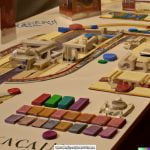Are you a fan of medieval strategy board games? If so, you’re in for a treat. In this article, we will delve into the captivating world of medieval strategy board games and explore their rich history, popular titles, key principles and tactics, as well as their influence in pop culture.
Medieval strategy board games have been a source of entertainment and intellectual challenge for centuries. From ancient origins to modern adaptations, these games have stood the test of time and continue to captivate players around the world.
Join us as we take a closer look at the top 5 most popular medieval strategy board games, examine the art of strategy behind these games, and explore their impact on pop culture. Whether you’re a seasoned player or new to the world of medieval strategy board games, there’s something here for everyone to enjoy. So grab your game board and get ready to embark on an exciting journey into the realm of medieval strategy gaming.
The History of Medieval Strategy Board Games
Medieval strategy board games have a rich and diverse history that spans centuries, with their origins rooted in ancient civilizations. From the earliest known board games like Senet in ancient Egypt to the modern adaptations of games like Chess and Go, the evolution of medieval strategy board games is truly fascinating.
The history of medieval strategy board games can be traced back to ancient Mesopotamia, where some of the earliest known board games were played. These early games were not only forms of entertainment but also served as tools for teaching military strategy and tactics. As civilizations across the world developed, so did the complexity and diversity of board games, leading to the creation of iconic medieval strategy games that are still popular today.
Key milestones in the history of medieval strategy board games include the introduction of Chess from India to Persia in the 6th century, and its subsequent spread throughout Europe during the Middle Ages. Similarly, Chinese strategy board games like Go have a long and illustrious history dating back over 2,500 years. These ancient origins laid the foundation for modern adaptations and variations of medieval strategy board games that continue to captivate players around the world.
To understand how these ancient origins have influenced modern adaptations, let’s take a closer look at some key milestones in the evolution of medieval strategy board games:
- The influence of ancient civilization: Mesopotamian, Egyptian, Indian, and Chinese civilizations contributed to the development of early forms of medieval strategy board games.
- The spread of Chess: From its origins in India, Chess became a popular game throughout Persia and Europe during the Middle Ages.
- Growth in popularity: Medieval strategy board games gained widespread popularity among nobility and commoners alike during various periods in history.
As we continue to explore this section on The History of Medieval Strategy Board Games: From Ancient Origins to Modern Adaptations, it becomes evident that these timeless games have truly stood the test of time.
The Top 5 Most Popular Medieval Strategy Board Games
Chess: The Classic Game of Warfare
Chess is arguably the most well-known and widely played medieval strategy board game. Originating in India during the Gupta Empire, it has transcended time and culture to become a global phenomenon. With its intricate rules and diverse set of pieces, chess remains a favorite among strategy enthusiasts, serving as the ultimate test of tactical skill and foresight.
Checkers: A Timeless Battle of Wits
Dating back to ancient Egypt, checkers has stood the test of time as a beloved medieval strategy board game. Known for its straightforward gameplay and strategic depth, checkers requires players to anticipate their opponent’s moves while simultaneously planning their own. Its accessibility and engaging nature have ensured its enduring popularity across generations.
Backgammon: An Ancient Game of Chance and Skill
With origins tracing back to Mesopotamia, backgammon combines elements of luck and strategy, making it a unique addition to the world of medieval strategy board games. Players must navigate their pieces around the board while making calculated decisions based on dice rolls. This blend of chance and skill has captivated players for centuries, solidifying backgammon as a cornerstone of traditional gaming.
These three games exemplify the timeless appeal and engaging nature of medieval strategy board games. Whether through the cerebral challenges of chess, the strategic depth of checkers, or the blend of chance and skill in backgammon, these iconic games continue to inspire players worldwide. As we delve into the top 5 most popular medieval strategy board games, it becomes clear that these timeless classics still hold immense allure in today’s gaming landscape.
The Art of Strategy
Medieval strategy board games have been a source of entertainment and intellectual challenge for centuries. Mastering these games requires an understanding of key principles and tactics that can lead to victory. Whether playing chess, Nine Men’s Morris, or Hnefatafl, players must carefully consider their moves and anticipate their opponent’s strategies in order to outwit them.
To excel at medieval strategy board games, it is essential to familiarize oneself with the basic principles of each game. Understanding the rules and objectives is crucial for developing effective strategies. Additionally, learning about the historical context and cultural significance of these games can provide valuable insight into the mindset of the people who played them centuries ago.
When it comes to tactics, medieval strategy board games require critical thinking, spatial awareness, and foresight. Players must carefully plan their moves in advance while also remaining flexible enough to adapt to their opponent’s actions. By anticipating potential threats and opportunities on the board, players can position themselves for success. Here are some key principles and tactics for mastering medieval strategy board games:
- Anticipate your opponent’s moves and plan your own accordingly
- Control the center of the board to limit your opponent’s options
- Formulate a long-term strategy while remaining adaptable to changing circumstances
- Keep track of your opponent’s pieces and be mindful of any potential threats they may pose
By honing these key principles and tactics, players can enhance their strategic skills and elevate their gameplay in medieval strategy board games. Whether playing casually with friends or competing in tournaments, mastering these time-honored games offers a rewarding challenge that transcends generations.
Medieval Strategy Board Games in Pop Culture
Medieval Strategy Board Games on the Big Screen
The influence of medieval strategy board games in popular culture can be seen in various movies. Films such as “WarGames” and “Jumanji” showcase the excitement and intensity of playing these historical games. These movies have brought attention to the thrill of medieval strategy board games, inspiring a new generation of players to explore this ancient form of entertainment.
Television Shows and Medieval Strategy Board Games
In addition to movies, television shows have also featured medieval strategy board games as part of their plots or themes. Whether it’s a historical drama set in the medieval period or a modern-day series with characters engaging in strategic gameplay, these portrayals have further embedded the allure of these games into popular culture. Shows like “Game of Thrones” have heightened interest in medieval strategy board games, with fans eagerly seeking out similar gaming experiences.
Literature and Gaming
The influence of medieval strategy board games can also be found in literature. Authors often incorporate these games into their stories, whether as a central element or simply as a background detail. From epic fantasy novels to historical fiction, the inclusion of medieval strategy board games adds depth to storytelling and captures the imagination of readers worldwide. As a result, literary works have played a significant role in perpetuating the cultural significance of these timeless games.
A Look at the Global Community of Medieval Strategy Board Gamers
The global community of medieval strategy board gamers is a vibrant and diverse group that shares a passion for these timeless games. From local meetups to international tournaments, enthusiasts come together to celebrate their love for games like chess, Go, and Tafl. These gatherings provide an opportunity for players to connect, learn from each other, and compete in friendly matches.
Tournaments are a popular way for medieval strategy board gamers to test their skills against others. These events often attract players of all ages and skill levels, creating a welcoming environment for newcomers and seasoned veterans alike. From small local competitions to large-scale international championships, there is no shortage of opportunities to showcase strategic prowess and engage in thrilling gameplay.
In addition to in-person events, many medieval strategy board gamers also participate in online communities dedicated to these games. Websites and forums provide a space for players to share tips, discuss strategies, and organize virtual matches. This digital aspect of the community has allowed enthusiasts from around the world to connect and engage with each other regardless of geographic location.
| Medieval Strategy Board Gamers Community | Tournaments & Conventions |
|---|---|
| Global network of enthusiasts | Opportunities for players to test their skills |
| In-person events and online communities | Mix of local meetups and international championships |
| Connect with players worldwide | Digital platforms for sharing tips and organizing virtual matches |
Unleashing Your Creative Side
Creating and customizing your own medieval strategy board game can be a rewarding and enjoyable experience for many enthusiasts. Whether you are looking to add a personal touch to an existing game or build an entirely new concept from scratch, the possibilities are endless. Customization allows you to tailor the game to your preferences, incorporate unique elements, and showcase your creativity in a tangible way.
One of the first steps in customizing a medieval strategy board game is to determine the theme and setting. Will it be set in medieval Europe, featuring knights, castles, and battles? Or perhaps it will draw inspiration from ancient civilizations such as Rome or Egypt? The theme sets the stage for the overall design and gameplay of the game, so it’s important to choose one that resonates with both the creator and potential players.
Next, consider the mechanics and rules of the game. Will it be a resource management game with elements of warfare, or will it focus more on diplomacy and alliance-building? The mechanics should align with the theme while also providing engaging and strategic gameplay for participants. Many popular medieval strategy board games have simple yet effective mechanics that allow for in-depth strategic thinking.
Finally, once the theme and mechanics are established, it’s time to create the components of the game. This may include designing a map or board, crafting playing pieces, developing cards or tokens, and creating any additional elements such as dice or player aids. Modern technology has made this process easier than ever, with numerous software programs available for designing game components.
Creating custom medieval strategy board games not only provides an opportunity for personal expression but also allows individuals to share their passion with others through playtesting and potentially even publishing their creations. With dedication and creativity, anyone can bring their vision of a medieval strategy board game to life.
| Aspect | Description |
|---|---|
| Theme | Determine the theme and setting of the game |
| Mechanics | Consider the mechanics and rules |
| Components | Create all components of the game |
The Future of Medieval Strategy Board Games
In conclusion, the future of medieval strategy board games is an exciting and promising one. With the ever-growing popularity of these games, there is a continuous demand for new innovations and anticipated releases. Game designers and developers are constantly pushing the boundaries to create immersive and engaging experiences for players, incorporating new trends and technologies to enhance gameplay.
One of the trends shaping the future of medieval strategy board games is the increasing prevalence of digital adaptations. While traditional board games will always have a special place in the hearts of enthusiasts, digital versions provide convenience and accessibility, allowing players to enjoy their favorite games on various platforms. This evolution opens up new possibilities for game mechanics and storytelling, creating a dynamic gaming experience.
Furthermore, the future holds potential for more collaborative gameplay experiences and customizable content. Players can look forward to innovative game mechanics that offer unique challenges and strategic depth.
Additionally, anticipated releases are expected to bring fresh themes and narratives to the medieval strategy board game genre, captivating both seasoned players and newcomers alike. As technology continues to advance, it’s certain that the world of medieval strategy board games will continue to evolve and thrive, offering endless opportunities for creativity and enjoyment beyond measure.
Frequently Asked Questions
What Was a Popular Board Game in the Middle Ages?
A popular board game in the Middle Ages was “Chess.” It originated in India and spread to Europe, becoming a favorite pastime for nobility and commoners alike. Chess requires strategic thinking and planning.
What Is the Most Famous Strategy Board Game?
The most famous strategy board game is “Chess.” With its origins dating back over a thousand years, Chess has captured the imagination of people around the world. It requires deep strategic thinking and foresight to win.
What Strategy Board Game Has Knights?
A strategy board game that features knights is “Catan.” In this game, players take on the roles of settlers, building and developing settlements while trading and acquiring resources. Knights play a role in protecting settlements from other players.

I love playing all kinds of games – from classics like Monopoly to modern favourites like Ticket to Ride.
I created this blog as a way to share my love of board games with others, and provide information on the latest releases and news in the industry.





